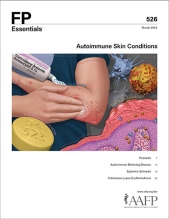
This clinical content conforms to AAFP criteria for CME.
There are many types of autoimmune blistering skin disease. Two of the most common are bullous pemphigoid and pemphigus vulgaris. Bullous pemphigoid is characterized by tense bullae created by a subepidermal split resulting from autoantibodies targeted at the hemidesmosomes at the dermal-epidermal junction. Bullous pemphigoid typically occurs in elderly people and often can be drug-induced. Pemphigus vulgaris is characterized by flaccid bullae because of an intraepithelial split triggered by autoantibodies targeting desmosomes. Diagnosis can be made for both conditions by physical examination, biopsy for routine histology, biopsy for direct immunofluorescence, and serologic studies. Both bullous pemphigoid and pemphigus vulgaris are associated with significant morbidity and mortality and diminished quality of life, making early recognition and diagnosis paramount. Management proceeds in a stepwise approach using potent topical corticosteroids along with immunosuppressant drugs. Rituximab recently has been shown to be the drug of choice for most people with pemphigus vulgaris.
Case 2. SH is a 40-year-old patient who comes to your office with extensive oral erosions, dysphagia, and flaccid blisters on the chest. These symptoms have been present for several months and are getting progressively worse. He has been losing weight because he has not been able to eat.
Pemphigoid disorders describe a group of autoimmune blistering disease characterized by separation at the basement membrane zone (BMZ), leading to subepidermal blisters. This group includes bullous pemphigoid, linear immunoglobulin (Ig) A bullous dermatosis, mucous membrane pemphigoid, pemphigoid gestationis, epidermolysis bullosa acquisita, and bullous lupus. Bullous pemphigoid is the most common of the subepidermal blistering disorders (and is the most common among all autoimmune blistering disorders).47 Pemphigus conditions are characterized by intraepidermal separation of keratinocytes because of antibodies against parts of the desmosome. This group contains such conditions as pemphigus foliaceous, paraneoplastic pemphigus, IgA pemphigus, fogo selvagem, pemphigus erythematosus, and pemphigus vulgaris.48 Of the intraepithelial blistering disorders, pemphigus vulgaris is the most common (comprising approximately 70% of cases).
Subscribe
From $350- Immediate, unlimited access to FP Essentials content
- 60 CME credits/year
- AAFP app access
- Print delivery available
Edition Access
$44- Immediate, unlimited access to this edition's content
- 5 CME credits
- AAFP app access
- Print delivery available
